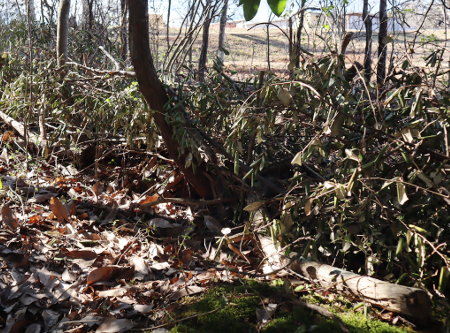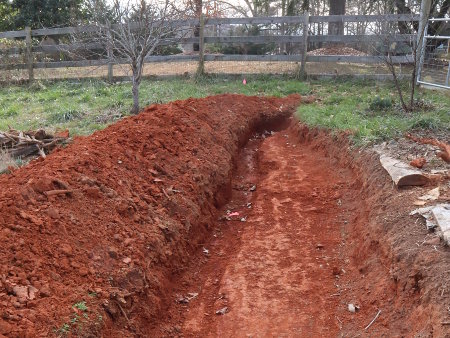Closing out February with some miscellaneous photos I took this month.
February 25, 2022
February 21, 2022
Brush Fence
Some of our property is fenced, some of it isn't. The garden and pastures are, but our woods aren't. But the woods is where I take the goats to browse, and while they mostly stick close to me, they don't recognize property lines and don't mind invading the neighbors to see what they've got growing.
We've talked about fencing the woods, but it would be a big job. It just never makes it close to the top of the to-do list. One reason for that is because we've had a lot of pine trees fall since we bought the place.
 |
| I cut them and pile them up along the property line. |
 |
| Once the piles get high enough, the goats stay on their side. |
 |
| Trees along the property line help hold them in place. |
 |
| Every year or so they settle and need more branches piled on top. |
 |
| Progress is slow, but I'm getting my walking trails back. |
 |
| I work on it until the goats head back to the barn. |
February 17, 2022
Book Review: Preserving Food Without Freezing or Canning
February 13, 2022
Winter Project List: Indoor Stuff
Even though winter is the slow-paced season, there's still plenty to keep us busy. I've shown you our outdoor projects, but because they are "weather permitting," the indoor project list is the to-do source when it's too cold, rainy, snowy, icy, muddy, or otherwise yucky outside. Last week, I defrosted a big bag of bones for making broth and my frozen figs for making jam.
The bone broth is pretty straightforward (my how-to here). It just requires planning ahead because the process spans four or five days.
 |
| I made and canned almost 2 gallons of bone broth for soups and gravy. |
Figs make a pretty bland jam, so I like to mix them with other fruits for some tasty combinations. After defrosting, I had enough to make two batches.
 |
| I used half of the figs for a fig/dried apricot jam. |
 |
With the other half, I used fresh cranberries for cranberry-fig jam. |
As you can see, I have plenty of interesting things to keep me busy! So, how about you? Are you working mostly indoors or out? Are you making headway on your project list? Or are you taking it easy this cold-weather season?
February 9, 2022
Forest Garden Update: What I've Been Planting
Here's another update from my winter outdoor project list. Besides swales, I'm working on my forest garden. (Planning pictures and lists are here). I started planting in September, but except for the pawpaws, I haven't made a blog record yet. This post is to rectify that!
I started by transplanting seedlings that I found elsewhere on the property.

|
|
Pecan seedling. I've also been planting these in our woods, like the pawpaws and persimmons. |

|
|
The first of two transplanted redbuds. Besides edible flowers, redbuds
are nitrogen fixers. It's mulched with chop and drop from nearby crepe myrtles. |

|
|
Also, I scattered redbud seed pods everywhere. This spring, I have 10 more seedlings coming from our state forestry service. |

|
|
Oak guild strawberry bed, with 1st transplants in the ground. In addition to strawberries, I also planted garlic in the bed. |
As an experiment, I tried an idea from Bill Mollison. Instead of a swale, I dug a pit in the center of the bed for capturing water.

|
| That is, I dug as much as the oak roots would let me. |

|
|
Once dug, the pit is filled with wood chips. The pairs of bricks are my stepping stones. |
I don't know how well the pit will work, but it's not a spot for a swale.

|
|
A couple months later, the strawberry plants and garlic were doing well and tucked in with a layer of oak leaves. |

|
|
The last of my transplants was my potted golden seal. I also ordered more roots to expand my golden seal bed. |

|
| Wild ginger. |

|
|
Hostas. These started off well and then got munched down, probably by skunks. Will they survive? Unknown. |

|
|
One of two spice bushes, before it dropped its leaves. I marked all my plantings with stones or bricks, so I'll know where to find them! |
Here's another mulberry (which I now know I can propagate with cuttings). It's dormant now, but beginning to bud.

|
| Mulberry |
Next, I planted honeyberries (haskap). These were pretty much just sticks with roots when I planted them. Even now, I'm wondering if they're alive.

|
|
Scraping away the outer bark with my thumbnail reveals it's green and still alive! |
Haskap are primarily found in colder regions, but these varieties are said to do well in my USDA growing zone, so we'll see. They may require a little pampering the first several years, but if I can get them established, it will be worth it.
And here's my map, so I can remember where everything is planted.
 |
| The fuzzy green circles are the mature oaks. |
That's my progress so far. I think I'll add a path next. This spring, I'll have more to plant, including adding some annuals into the mix. Looking forward to that!
February 5, 2022
Swale Update
This week, we got 3 inches of rain, so I thought a swale update was in order.

|
| Our first swale, hand dub, at the top of the garden. |

|
| 3 inches of rain. |
February 4, 2022
Last Day to Enter the Giveaway!
One more day to enter the giveaway for one of four paperback copies of How To Bake Without Baking Powder over at Permies.com. Winners will be announced tomorrow.
It's been fun discussing this subject with folks, and a lot of people have been surprised to find out that the book isn't just about homemade baking powder, nor focused only on things like sourdough. To get a better idea of the subject matter, I've started three threads at Permies that delve deeper into baking powder alternatives:
Permies is open to the public, so you don't have to have an account to read these. You only need an account if you wish to comment or want to enter the giveaway.
So, don't miss your chance! Come on over to Permies! If you'd rather skip the giveaway and simply purchase a copy, you'll find all the options here.

















